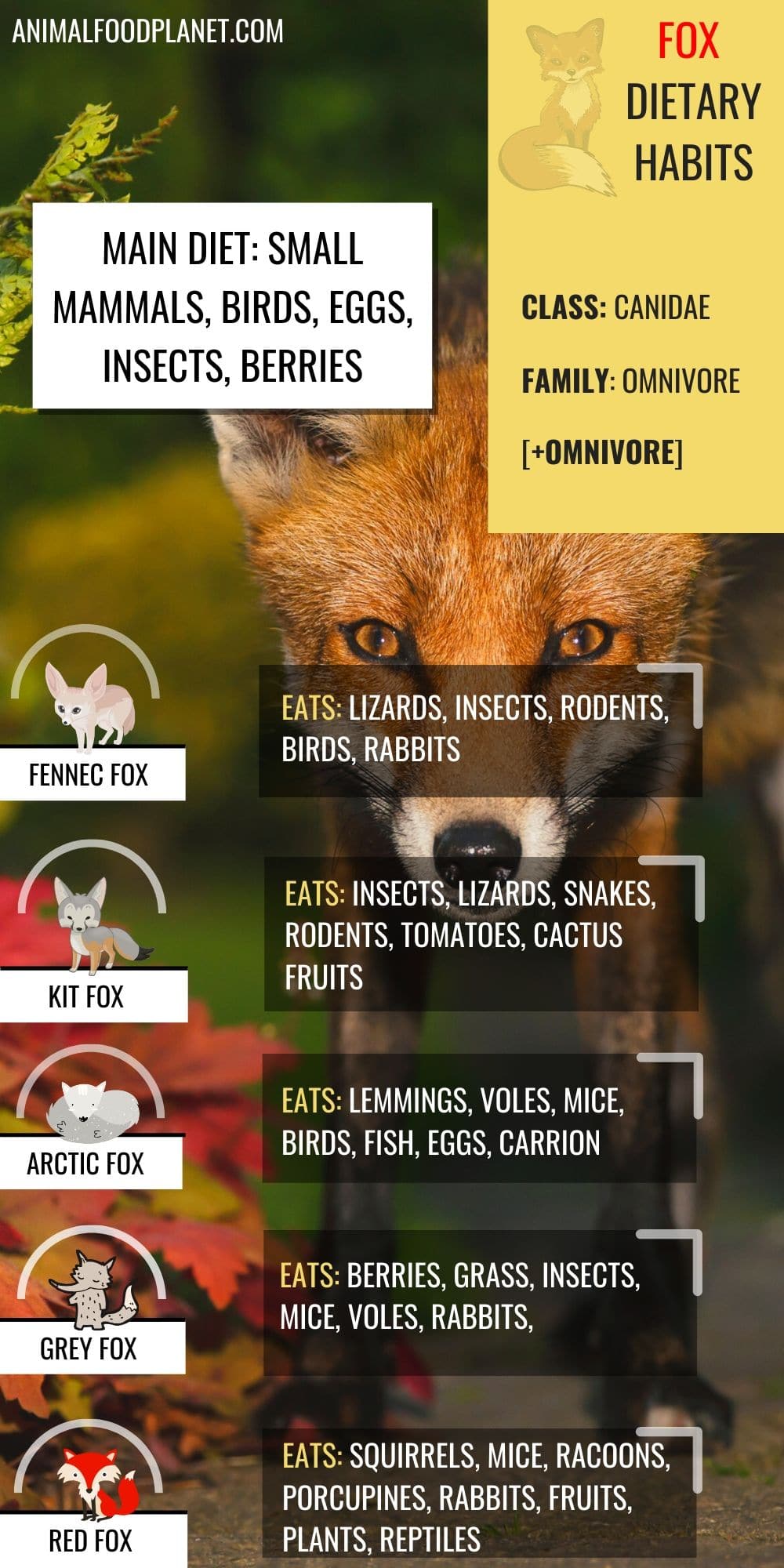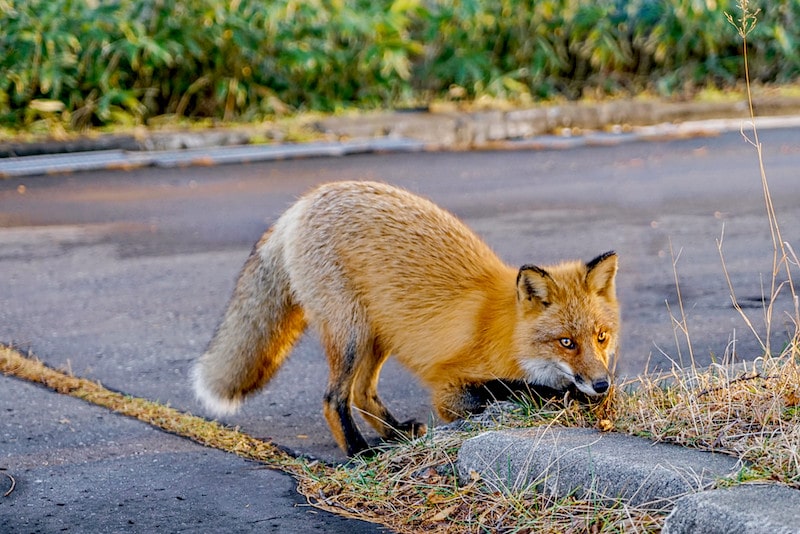Usually represented in folklore as a cunning trickster, the fox is an intelligent animal. The true nature of the fox is quite conspicuous.
Foxes are indeed intelligent and prefer to use that for their gain. They are lurking around as if more closely related to a cat. But what does this quick-witted creature stalk so cleverly? What do foxes eat in the wild? This is what this article is about, the fox’s diet.
What Do Foxes Eat?
Foxes eat small mammals, fish, birds, eggs, insects, earthworms, berries, and insects. They typically hunt during the evening hours, making them a nocturnal species. They prefer high-protein food rich in fat. Foxes are also known to travel from one place to another in search of food, but this depends on where they live.

What Do Foxes Eat?
The Fox Taxonomy
A background on foxes will aid in understanding what they eat and why.
The fox is a member of the family Canidae which makes up of dogs, wolves, and jackals. There are 37 known species of foxes, though only 12 can be found in the genus referred to as Vulpes, or the “true foxes”.
Separating themselves from the other canids, these individuals typically share a bushy tail, shorter body, slender legs, and ears that are large and erect. Each of these traits helps the fox to locate and capture its prey.
Those listed in the genus Vulpes can be found worldwide, making them an interesting study. Due to their widespread distribution, separate species can be observed hunting different types of prey.
To truly grasp how unique foxes are and what they eat, we must look at the more commonly known Vulpes.
What Do Foxes Eat in Urban Areas?
Urban foxes eat mammals, birds, vegetables, fruits, insects, earthworms, and household waste. They hunt their prey in the neighborhoods and streets of cities and towns.
According to Natural History Museum, the diet of foxes that live near urban areas changes from 95% meat based to no more than 50% meat based when living in urban areas.
What do Pet Foxes Eat?
A pet fox’s diet should be similar to a dog’s diet. It is a highly meat-based diet consisting of dog food, the occasional game, and fish.
Since foxes are omnivores, their diet needs to be well-balanced. According to Exotic Pet Wonderland, fruits such as cherries, apples, and kiwis and vegetables such as carrots and cucumbers are also part of a healthy pet fox’s diet.
What Do Foxes Eat in the Wild?
Foxes are highly adaptive, making them easy to adjust to different biomes, even if that were around humans. The following fox species can be found in specific habitats of their own, making them seek out certain food items.
What does the Fennec Fox eat?
The Fennec fox (Vulpes zerda) is known to be one of the smallest members of Vulpes. They typically weigh only between 2 to 3.25 pounds or 1 to 1.5 kilograms compared to other species that range from around 5 to 15 pounds or 2 to 7 kilograms.
In contrast to separate foxes, they are a tannish yellow or cream color with larger ears. These animals can thrive in the sandy habitats of North Africa, namely the Sahara Desert.
This fox is incredibly gifted in its ability to survive harsh desert conditions. Being nocturnal works in its favor as it can avoid the sun’s heat while foraging. Their large ears help to find a variety of lizards and insects that may burrow under the top layer of sand.
They also prey on rodents, birds, eggs, and rabbits, making them opportunistic omnivores. Some even have been found to climb palm trees to feed on fruit.
The Kit Fox Diet
Another small species, the Kit fox (Vulpes macrotis) weighs between 3.5 to 6 pounds or 1.5 to 2.7 kilograms. A Kit fox’s body is different compared to other members of Vulpes.
There is still the bushy tail and the large ears, yet it has a more slender body than most foxes do. Being a desert-dweller itself, this individual relies on its hearing, hence the name “macrotis”, or “big ears”.
They have a smaller distribution than most foxes, limiting their range to the southwest regions of the United States and Mexico.
One subspecies is the San Joaquin Kit fox (Vulpes macrotis mutica) which has become endangered due to the threatened species of plants and animals it consumes. Unfortunately, there are only approximately 7,000 left in the wild.
The Kit fox uses its large ears to find insects, lizards, snakes, and rodents.
Kit foxes also eat a variety of small rodents and birds that stay close to the ground. Living in scrublands, deserts and grasslands means they must adapt to their surroundings and find whatever they can when food is scarce.
During harsher seasons, they tend to consume tomatoes and cactus fruits to satisfy their daily requirements.
What does an Arctic Fox eat?
As the name would suggest, the Arctic fox (Vulpes lagopus) is known for its white coat. This isn’t the only case as its fur changes color in summer, morphing into a mixture of greys and whites.
Different from the previously mentioned foxes, this species has a thicker coat, smaller ears, and a bushier tail. These features help it to stay warm in the cold climates of the tundra, namely around Alaska, Canada, Greenland, and Iceland.
Living in such a cold environment, the Arctic fox must make do with what it can find. This generally includes various small animals such as lemmings, voles, and mice.
One of their largest prey items is the snowshoe hare. In addition, these foxes also consume birds, fish, eggs, and the occasional carrion if they come across it.
The Grey Fox Diet
The Gray fox (Urocyon cinereoargenteus) is not a member of Vulpes, but is considered a true fox by most. These animals still match Vulpes’s description yet have shorter legs than their body size.
It typically weighs between 6 to 15 pounds or 3 to 7 kilograms.
The Gray fox sports a mixture of black, white, gray and reddish-brown colorations. It is easily identified by the long tail that has a black-tipped stripe along the top.
They are found throughout North America, extending slightly into the northwest corner of South America. This species lives in mountainous regions with forest and woodland habitats.
Being the only living member of the genus Urocyon, the Gray fox is a tree-climbing canid.
During certain seasons, they depend on berries, grass, insects, and small animals. This species tends to hunt mostly mice, voles, and Eastern cottontail rabbits. Although they are mostly nocturnal, they can be seen hunting during the day.
What does the Red Fox eat?
When one thinks about a small wild canine, one typically thinks of the Red fox (Vulpes vulpes). Being the pinnacle of the true foxes, this species is also the largest and most widely dispersed individual.
With a distinctive red coat, dark legs, and a bushy tail accompanied by a white tip, the Red fox weighs in at around 6 to 15 pounds or 3 to 7 kilograms.
The native populations can be found all over the Northern Hemisphere in various habitats such as meadows, farmlands, forests, and suburban areas.
The diet of a Red fox is dependent on the location and season.
They also have a larger diversity when it comes to their meal preferences. As for other mammals, these foxes stalk squirrels, mice, raccoons, porcupines, and rabbits.
Red foxes consume various fruits, such as blackberries, grapes, apples, and acorns. In addition, one can find them eating plants, songbirds, reptiles, fish, and insects, to satiate their appetites. This incredibly expansive diet allows them to travel between habitats quite easily.
What Do Foxes Eat in Different Seasons?
Although foxes are considered opportunistic feeders, certain species have to modify their meal preferences depending on the season.
Red foxes and Fennec foxes are examples of diets changing seasonally. Regardless of if you live in the snow, or the desert, the atmosphere can drastically change. It is essential to adapt and find abundant prey in these environments to survive.
For instance, the Red fox feeds primarily on small mammals during the colder months, whereas Fennec foxes dig up beetles to escape the freezing conditions.
During the spring and summer, Red foxes change their hunting strategies to locate berries and various species of invertebrates such as beetles, grasshoppers, and caterpillars. The Fennec fox will burrow into tunnels during the warmer months to find small mammals.
These two examples show that diets differ not only depending on the season but can also vary based on where the fox lives.
How Do Foxes Hunt?
Foxes are avid hunters, usually choosing to hunt live prey as opposed to finding berries or beetles. Due to their adaptations, foxes can successfully stalk their prey by themselves rather than in large groups.
Being a canine has its perks. With exceptional night vision and large ears, foxes are able to locate their prey in the darkest hours of the day. Another adaptation is their ability to walk on hot sand or snow. The fur covering their paws acts as modified snowshoes.
One distinctive way a fox will hunt is through pouncing, usually in snow-covered habitats. Wild dog species like wolves and coyotes don’t portray this behavior. Instead, it is commonly seen in cats, making the fox unique from its canid relatives.
When an Arctic fox needs to find prey, it has to rely on its senses. Using its nose and ears, it will lurk along the ground until a scent is picked up or until it hears a rodent underneath.
Once the target has been acquired, the fox will jump into the air, coming down hard onto the burrow’s entrance with its front paws. After a few attempts, the Arctic fox can successfully prey upon a lemming or vole.
These strategies are key in surviving and eating as a fox in the winter. Individuals such as the Arctic fox are masters at hunting, even with small mammals burrowing under the snow.
Read more about what an arctic fox eats in this article.
Do Foxes Drink Water?
For foxes who live in forested regions, farmlands, suburban areas, and grasslands, water availability is not an issue. The Red fox and Gray fox can find streams, puddles, or even domesticated animals’ water bowls.
The Arctic fox will also have steady access to liquids during the warmer seasons. It is the harsher conditions that prove to be more challenging.
When considering the lifestyle of a Kit fox, Fennec fox, or even an Arctic fox during the winter, it is clear to see that water is scarce.
All these species can survive in areas with little to no water for an extended period. They achieve this by consuming prey with enough liquid.
The Fennec fox and Kit fox can survive in regions that do not have water due to this adaptation. You would assume that the Arctic fox could take advantage of the frozen liquid since it is surrounded by ice.
This would be detrimental since eating the snow or ice would severely lower the temperature of the animal’s body. Absorbing the liquid from the prey eaten is less harmful.

Fox diet
What is Fox’s Favorite Food?
Foxes will eat an assortment of foods, such as insects, small mammals, birds, and berries, but which food is their favorite? With any wild animal, it is important to determine how much energy goes into hunting.
In other words, it must be worth the cost. Most species of foxes, regardless of where they live, seek out small rodents such as hares and mice.
These are relatively easy to stalk and multiply quickly for an abundant meal. Some foxes also appear to enjoy the game of hunting rodents, as they can be seen tossing these prey items in the air.
Why Do Foxes Have Such a Long Tail?
One distinctive feature that a fox has is its long, bushy tail. This iconic physical characteristic has a purpose, other than being aesthetically pleasing.
Year-round, these tails are used for balance when hunting. But for those harsher winter months, they can be used as a heating tool.
Foxes having to deal with these conditions use their tail and place it over their nose while they curl up into a ball.
If you were to watch sled dogs, you would see the same thing. It is a way for the cold air to stay out of the nose so the animal can stay warm.
Do Foxes Attack You?
As with any wild animal, it is important to keep a safe distance. Animals, when threatened, will try to defend themselves, their family members, and food sources.
The fox, in particular, is not especially dangerous to people. They’ve learned how to live around us, keeping out of our way.
The only fox to worry about would be a rabid one. If you see a fox staggering around with bared teeth and a foamy mouth, keep away and report them to Animal Control. Also, enjoy the sights, for they are beautiful and fascinating.
Do Foxes Eat Dogs?
Foxes are not known to attack dogs, mostly because they are usually bigger. These wild animals will rarely hunt down something larger in size.
If you have a small dog, keeping them inside during the evenings might be beneficial. But overall, a fox will not eat a domesticated dog.
Do Foxes Eat Cats?
Most cats are equivalent in size to a fox, if not somewhat smaller. Because of this, it is not out of the question for a fox to get into a fight with a cat. For the most part, it is rare to see a fox eat a cat.
They prefer to eat mice that are easier to catch. Hunting down a cat takes too much energy.
In fact, cats can be found eating fox cubs rather than the other way around. Do keep in mind that foxes will try to stalk smaller pets such as rabbits and guinea pigs. Your cat, on the other hand, should be safe.
What Should You Not Feed Foxes?
Foxes have diverse, opportunistic eating habits. Foxes do consume various berries, rodents, birds, lizards, amphibians, and even carrion when made available.
As with most canines, foxes cannot be fed chocolate or grapes. They have been known to eat a few grapes in the wild, but in larger quantities due to the toxicity in the seeds, which can lead to kidney failure.
It is also important to keep in mind that you should not feed a wild fox. Even if they are not entirely skittish when it comes to humans, they should not become habituated.
If you were to feed a fox over a few days, it could get close to people who could shoot them. It is for your safety, and the safety of the fox, that they should be treated like wild animals and not domestic dogs.
The fox is a cunning canid with a few cat-like characteristics. How they use their ears, long tails and coats is incredible, adapting to nearly every biome on this planet.
They can be seen stalking various prey, such as rodents, birds, insects, lizards, and amphibians.
These animals also rely on their omnivorous diet to survive by eating plants, berries, and apples. Depending on the species, these true foxes have become master adapters, making the best of seasonal changes.
The next time you see a fox, watch how conspicuous and careful it is.
Hunting and Foraging Behaviors of Foxes
One specific behavior of red foxes is called “mousing.” This is when the fox jumps high and surprises its prey from above, according to The Royal Society.
In addition, foxes have great hearing ability. This helps them in locating prey.
In addition to sound, scent plays a vital role. Foxes often frequent areas up and down and rely on their hearing and smelling ability simultaneously, according to the College of Environmental Science and Forestry.
How Urbanization Affects Foxes
The alternation of living grounds for foxes happens at a rapid pace. Interactions with humans become more frequent.
Due to the abundance of food, foxes often inhabit urban areas, which results in a higher population density, according to PLoS Online.
The consumption of rodents is lower for foxes hunting in urban areas. They rely more on anthropogenic food, according to a study conducted in Estonia.
While altering the menu of foxes, urbanization has other positive and negative consequences. Diesease transmission is a negative consequence.
A more positive consequence is the increased well-being of humans that can spot and interact with these creatures.
Subspecies of Foxes and their Specific dietary habits
Kit fox (Vulpes macrotis)
They mostly eat insects, lizards, snakes, and rodents.
Swift Fox (Vulpes velox)
The swift fox consumes ground squirrels, prairie dogs, and voles.
Gray fox (Urocyon cinereoargenteus)
Gray foxes eat insects, small mammals, birds, and fruits as well as reptiles, fish, and crustaceans.
Arctic fox (Vulpes lagopus)
Arctic foxes eat lemmings, voles, and Arctic hares. They also eat fish, birds, and berries.
Fennec fox (Vulpes zerda)
Their diet consists of lizards and insects.
Conclusion On What Foxes Eat
Foxes are omnivores and eat the following animals and plants:
- Small mammals
- Birds
- Fish
- Eggs
- Insects
- Earthworms
- Berries


